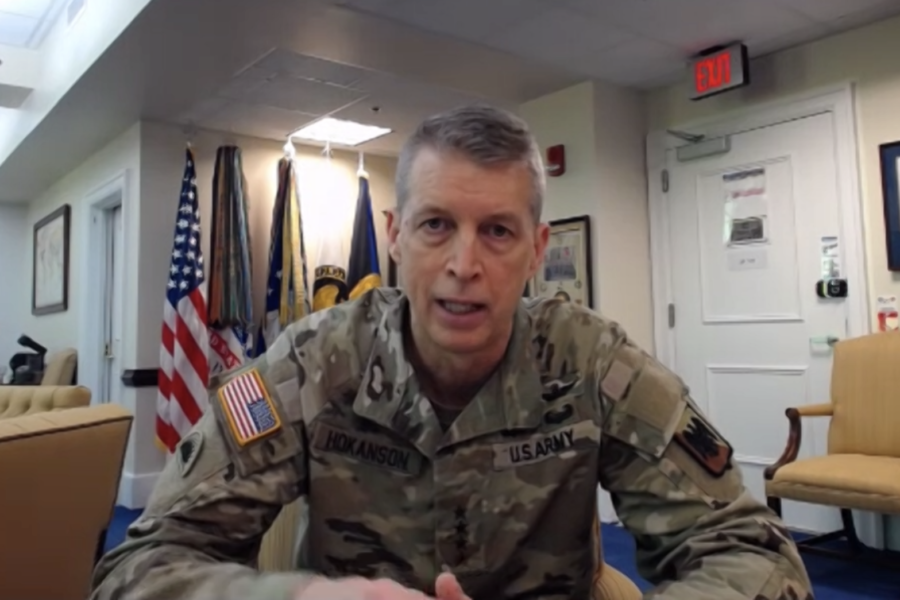While the Guard can’t force troops to get a COVID-19 vaccine, it is engaged in educational initiatives to keep personnel informed about what’s available, National Guard Bureau Chief Army Gen. Daniel R. Hokanson said.
NGB doesn’t track how many of its troops decline COVID-19 vaccines at the national level, but Washington Adjutant General Army Maj. Gen. Bret D. Daugherty said about 39 percent of the state’s overall Guard troops have opted to get a shot.
“We just try to educate people on the potential benefits of getting the vaccine and we’re doing the best we can to let people know that we’ve got vaccine available, and that there are some good points for opting in, but I can’t go beyond that to the point where I would appear to be having undue command influence in telling people to get vaccinated because it’s not a requirement yet,” he said during a March 5 press briefing with Hokanson and other states adjutant generals.
Nebraska Adjutant General USAF Maj. Gen. Daryl L. Bohac said his state’s Air National Guard is seeing a 42 percent “take rate”—12 percent higher than the rate being seen for the state’s overall Guard force. Nebraska Guard leaders are streaming events on YouTube and Facebook to help “get the word out” to troops about vaccination.
This month, the Nebraska Guard is also undertaking “a fairly aggressive campaign” to ensure that all troops who want a COVID-19 shot can get one, he said.
“One of the great things for us here in Nebraska is my senior Army National Guard surgeon general is a critical care pulmonologist … , and so he’s a ideal expert to talk about the impacts of the disease, but also to make an assessment of the vaccine and to provide people information. So, we’ve actually done some myth-busting kinds of outreach,” Bohac told reporters on the call. “And then we also put medical teams … out to the formations and make them available to do Q&A, which I think is the most important strategy that we have right now.”
The National Guard Bureau also has distributed fill-in-the-blank-style placards for people to take selfies with while or after they get vaccinated to help encourage others to do the same, NGB spokesperson Tracy O’Grady-Walsh said during the Zoom call.
“We’ve found that that has really gained a lot of community support ‘cause they want to be there for each other, they wanna be in this together,” she said.
“At the state level,” she added, NGB has noticed that when state National Guards conduct town halls about COVID-19 vaccinations, “they immediately see those numbers jump.” It’s a logical trend, she noted.
“The more informed you are about the vaccine, the more comfortable you’re gonna feel with it.” she said.
During a Feb. 19 interview with Air Force Magazine, Air National Guard Director Lt. Gen. Michael A. Loh said approximately one-third of ANG personnel had opted out of getting a shot.
He noted that he’s heard anecdotally that troops aren’t necessarily deciding against it because they’re anti-vaxxers. Rather, many don’t feel comfortable getting access to vaccines before loved ones who are more vulnerable to the virus.
“I don’t know if they actually denied it, or they just said ‘no, I’ll pass,'” Loh said. “And I say that because, when you’re dealing with a young, healthy population, and they’re dealing with parents and grandparents that can’t get the vaccine right now, there’s a lot of members that go, ‘Hey, I know I am not at the biggest risk, and so use it for those that are at the higher risk.’ So, I can’t tell you how many would have actually … said, ‘Hey, … I don’t believe in vaccines, I believe in letting the body do its own thing.’”
NGB still lacks sufficient vaccines for all of its troops, Hokanson noted, projecting that the bureau won’t have that kind of stock “until later in April.”
In the meantime, he said, “the best” thing the bureau can do is to keep holding open forums about the vaccines so Guardsmen can ask questions, and have candid conversations with forces about the upsides of getting vaccinated, as well as “the concerns that we’re seeing with the disease itself.”
